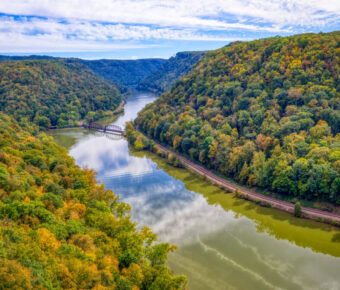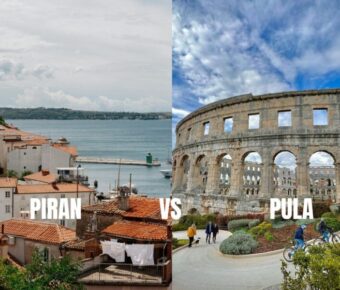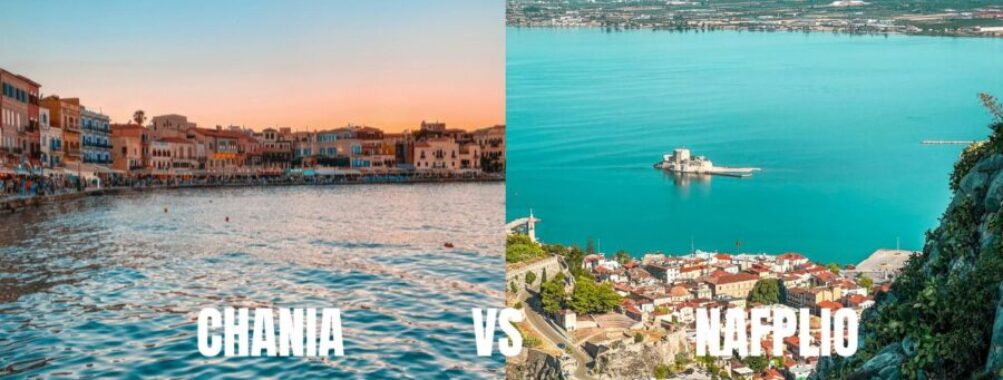
Chania vs Nafplio: Ultimate Guide to Greece’s Most Charming Towns
Picking between Chania and Nafplio? It’s tough, honestly. It all depends on what kind of Greek escape you’re craving. If you’re after lively beaches, epic hikes, and a bustling food scene, Chania’s your spot. But if you’re dreaming of charm, walkability, and a romantic vibe, Nafplio steals the show. Both towns ooze history and culture, but the energy shifts the moment you step in.
You’ll sense it immediately. Chania buzzes—think Venetian harbor, lively markets, and wild Cretan landscapes just beyond town. Nafplio, though, moves at a gentler pace. Stone streets wind through car-free squares, and Palamidi Castle stands watch overhead. I’ve wandered both, and honestly, it comes down to whether you want to feel the pulse or just slow down and soak it in.
Table of Contents
- Key Takeaways
- Chania vs Nafplio: Key Differences at a Glance
- Geographical Setting and Accessibility
- Atmosphere and Local Vibe
- Historical Significance
- Architectural Styles and Old Towns
- Venetian and Turkish Influences in Chania
- Neoclassical and Italian Flair in Nafplio
- Cultural and Historical Landmarks
- Fortresses and Castles
- Museums and Archaeological Sites
- Day Trips to Knossos and Surrounding Areas
- Beaches and Natural Beauty
- Best Beaches Near Chania
- Coastal Escapes Around Nafplio
- Food, Wine, and Nightlife
- Dining Experiences in Chania
- Culinary Scene in Nafplio
- Wine Culture and Local Specialties
- Travel Logistics and Itineraries
- Getting There from Athens
- Best Times to Visit
- Recommended Length of Stay
- Who Should Choose Chania or Nafplio?
- Best for History Buffs
- Ideal for Romantic Getaways
- Family-Friendly Options
- Frequently Asked Questions
- What unique historical sites can be explored in Chania compared to those in Nafplio?
- How does the culinary experience differ between Chania and Nafplio for food-loving travelers?
- Can you highlight the differences in the beach landscapes between Chania and Nafplio?
- What are the hidden gems for local culture in Chania and Nafplio that are off the beaten path?
- How do the accommodations in Chania stand out from those available in Nafplio?
- What seasonal events should visitors consider when choosing between a visit to Chania or Nafplio?
- Book Your Dream Experience
- More Travel Guides
Key Takeaways
- Chania’s packed with activities, beaches, and food options
- Nafplio is smaller, more romantic, and super easy to explore on foot
- The best pick really depends—do you want energy or relaxation?
Chania vs Nafplio: Key Differences at a Glance
Chania and Nafplio both rank high among beautiful Greek destinations, but man, do they feel different once you’re there. Chania sits on Crete, surrounded by beaches and mountains. Nafplio chills on the Peloponnese coast, radiating that quieter, romantic charm.
Geographical Setting and Accessibility
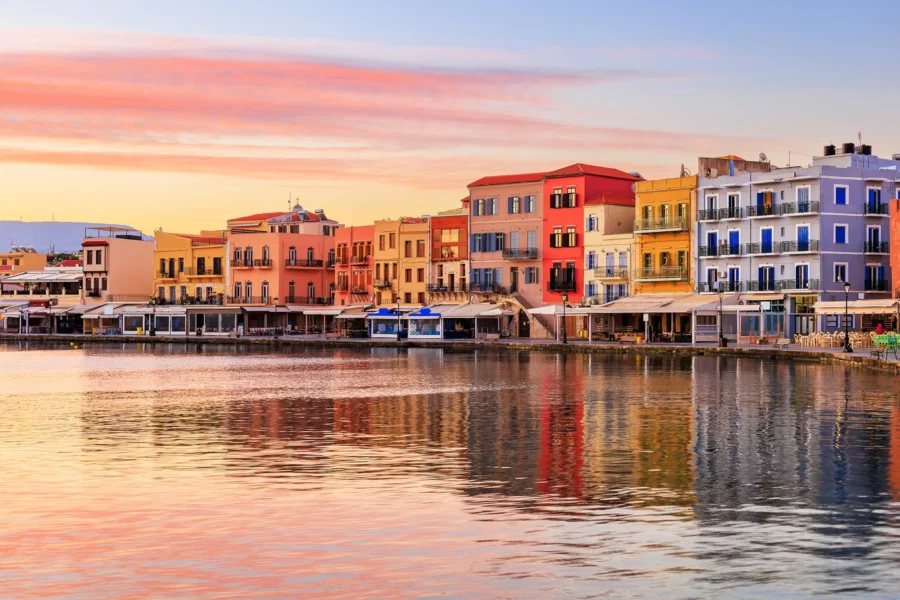
Chania hangs out on Crete’s northwest coast, and it’s the biggest island in Greece. You’ll probably fly into Chania International Airport or catch a ferry from Athens or maybe another island. Because Crete’s massive, you’ll want a car if you plan to explore beyond the old town or hit up those famous beaches.
Nafplio (sometimes you’ll see it as Nafplion) sits on the Peloponnese peninsula, just two hours from Athens by car. That makes it a favorite weekend spot for Athenians. You can get there by bus, but honestly, having your own wheels opens up nearby beaches like Karathona and ancient sites like Mycenae.
If you want an easy Athens add-on, Nafplio is a breeze. But if you’re itching to explore Crete’s gorges, wild beaches, and mountain villages, Chania’s your launchpad.
Atmosphere and Local Vibe
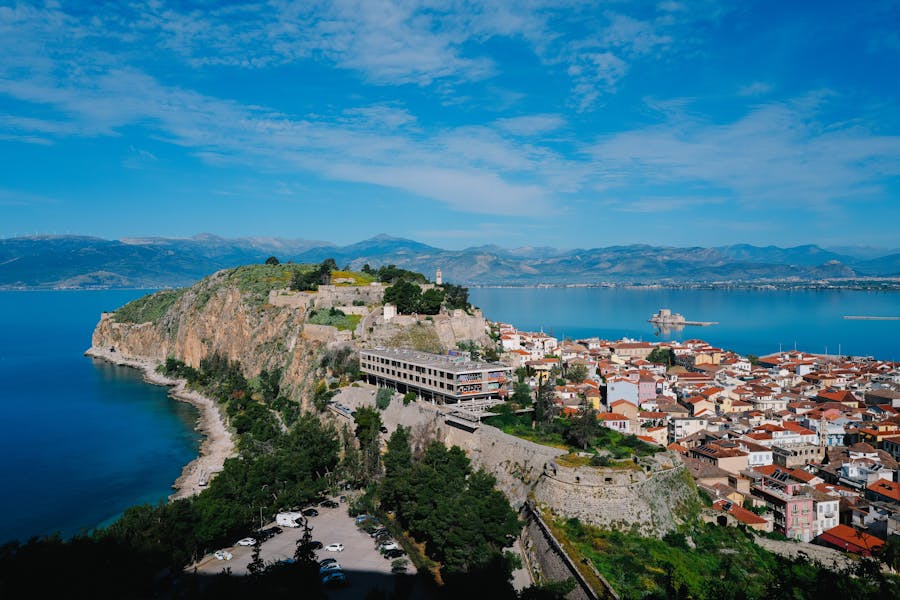
Chania brings a wild mashup of cultures. The Venetian harbor sets the scene, but Turkish-influenced buildings and lively markets add layers. The old town bustles with restaurants and shops, but if you duck down a side alley, you’ll find quiet pockets too. In summer, tourists definitely flock to the waterfront.
Nafplio, though, is all about a slower, romantic vibe. The old town’s made for walking—neoclassical houses, car-free squares, and cozy tavernas everywhere. At night, families stroll and couples sip wine by the sea. It’s less chaotic than Chania, and you’ll spot more Greeks than international visitors.
Nightlife and big-city energy? Chania takes the win. But for charm and intimacy, Nafplio’s hard to beat.
Historical Significance
Both towns wear their history proudly, but in their own ways. Chania’s story ties into Crete’s role in the Mediterranean. You’ll spot Venetian fortresses, Ottoman baths, and Byzantine churches all over. The Venetian Lighthouse stands out as a landmark, and the Archaeological Museum helps tie it all together.
Nafplio, meanwhile, played a starring role in modern Greek history. It served as the first capital of independent Greece in the 1800s. You can climb up to Palamidi Fortress for panoramic views, wander out to Bourtzi Castle on the water, or check out museums that tell Nafplio’s part in shaping the nation.
Chania shows off Crete’s layered past, while Nafplio highlights modern Greece’s birth. Both stories are fascinating, but the flavor’s totally different.
Architectural Styles and Old Towns
Chania and Nafplio both have old towns that feel like you’ve stepped into a living museum, but the stories they tell couldn’t be more different. One’s a wild blend of Venetian and Ottoman, the other’s got that neoclassical, Italian-inspired elegance.
Venetian and Turkish Influences in Chania
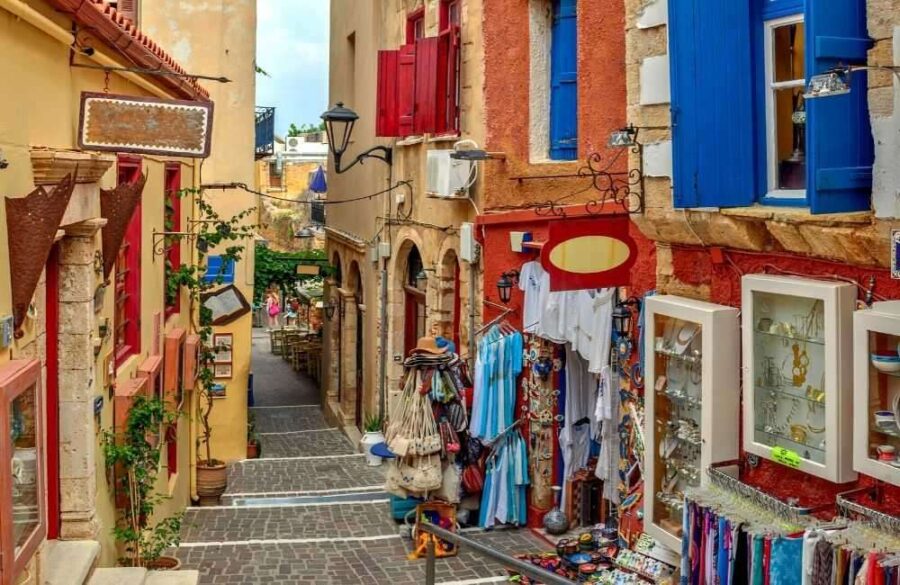
Walking Chania’s Old Town is like flipping through a history book, but the pages are all mixed up. The Venetian harbor, with its 16th-century lighthouse and chunky stone arsenals, grabs your attention first. As you wander inland, grand Venetian facades fade into Ottoman touches—wooden balconies, narrow winding lanes.
The vibe here isn’t polished. Some streets look a bit scruffy, honestly, but that’s what gives Chania its soul. You’ll spot buildings from the 1960s and 70s mixed right in, so the styles jumble together. It’s not always “pretty,” but it’s real and lived-in.
I’ll never forget sipping Greek coffee at a café by Firka Fortress, watching the harbor go golden at sunset. The Egyptian-built lighthouse looked almost out of place, but somehow, it just worked with the scene. Chania’s full of those odd, perfect moments.
If you love exploring less-manicured places, Chania’s Old Town delivers. You can wander from a Venetian church to a Turkish hammam in minutes, and the contrast sticks with you.
Neoclassical and Italian Flair in Nafplio
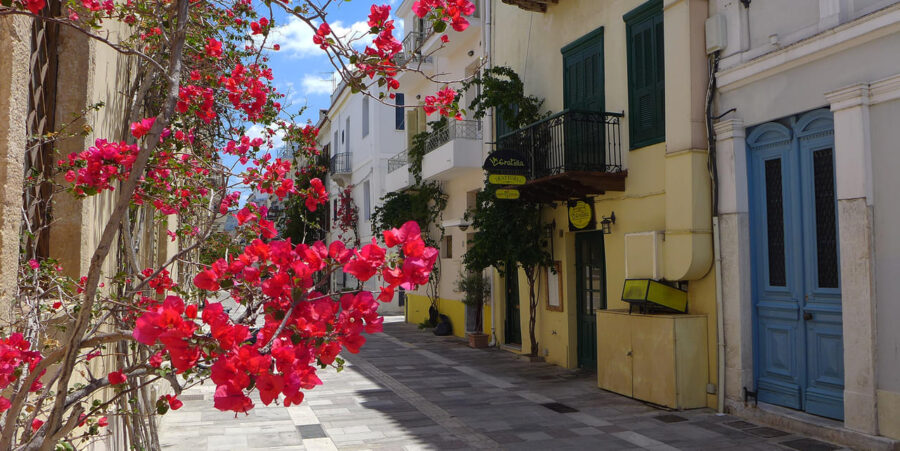
Nafplio, over on the Peloponnese, feels more put-together. The Old Town’s compact, super walkable, and beautifully preserved. Neoclassical mansions in pastel shades line the streets, with wrought-iron balconies and tiled roofs—a nod to its time as Greece’s first capital.
Unlike Chania, Nafplio’s streets seem carefully arranged. Cobblestone lanes spill into tidy squares with bustling cafés, and the whole place looks almost too perfect. Italian vibes are strong, especially around Syntagma Square where Venetian and neoclassical styles blend together.
I lost track of time just climbing the staircases toward Akronafplia fortress. Every turn brought another photo-ready corner—arched doors, bougainvillea everywhere, and the occasional Ottoman fountain hiding in the shade.
If you’re a sucker for romance and atmosphere, Nafplio’s got you. It’s no wonder people call it one of the most beautiful towns in Greece. The architecture feels curated, almost like a movie set, but in a way that makes you want to linger and just take it all in.
Cultural and Historical Landmarks
Chania and Nafplio both serve up history you can actually walk through. From Venetian fortresses to ancient ruins, each city opens a different window into Greece’s past, with plenty to explore on foot or as easy day trips.
Fortresses and Castles
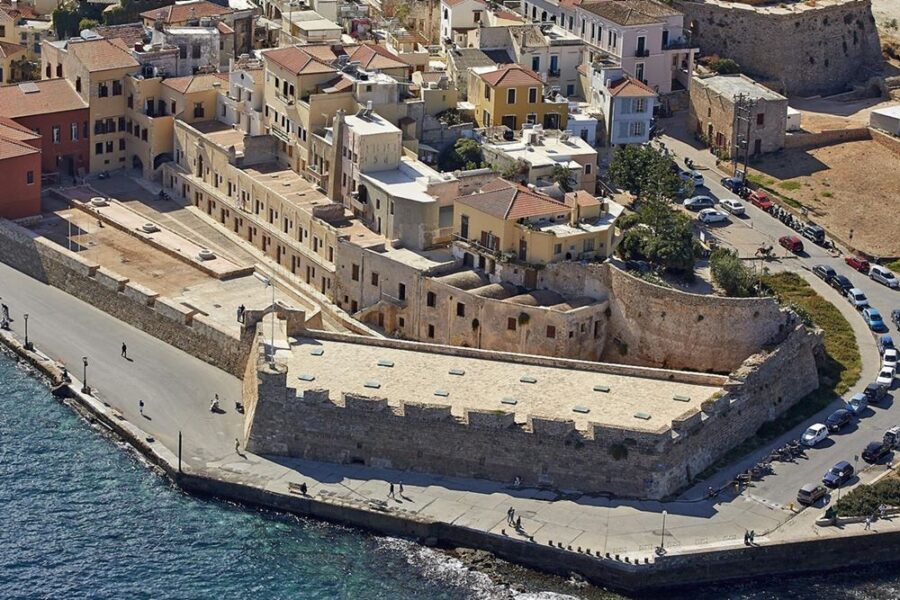
If you love dramatic fortresses, you’ll fall for Nafplio. The Palamidi Fortress looms over town, with 999 steps (okay, maybe not quite that many, but your legs won’t care). The view across the Argolic Gulf is a showstopper. Down by the water, Bourtzi Castle sits on its own little island, once guarding the harbor and even serving as a prison.
Chania, out on Crete, has its own set of Venetian defenses. The Firkas Fortress by the Old Harbor protected the city from Ottoman attacks. Walk the old walls and you’ll see how Venetian and Ottoman styles blend into Chania’s daily rhythm.
Nafplio’s castles dominate the skyline—you just can’t miss them. Chania’s fortifications, meanwhile, blend into the city, part of the everyday backdrop.
Museums and Archaeological Sites
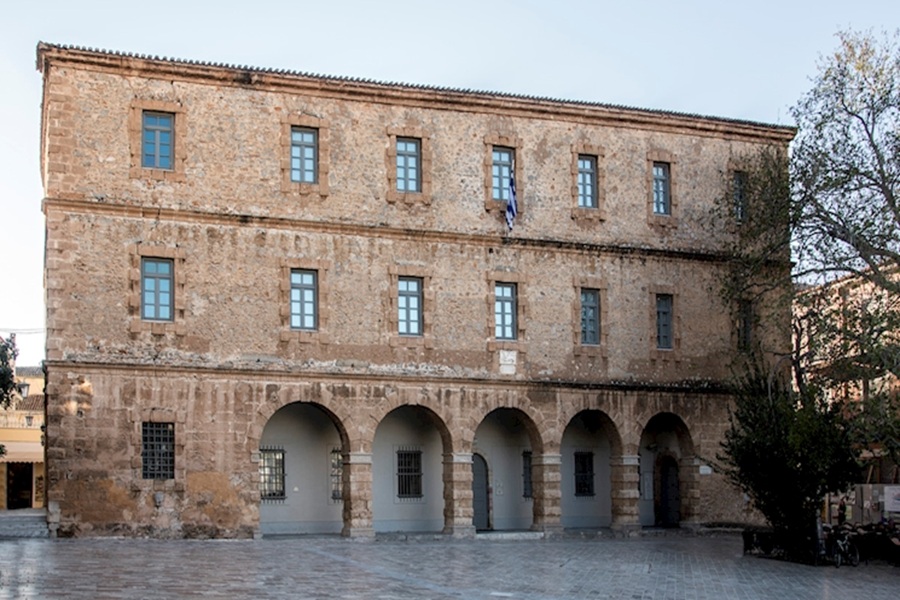
Nafplio packs a lot into its small museum scene. The Archaeological Museum of Nafplio houses treasures from Mycenaean times, including rare suits of armor. The War Museum sits inside a former military academy, telling Nafplio’s story as Greece’s first modern capital. You can see both in a single day, no rush needed.
Chania spreads things out more. The Archaeological Museum of Chania covers everything from Minoan pottery to Roman mosaics. The Maritime Museum of Crete, tucked inside Firkas Fortress, dives into Crete’s long naval history. If you’re into quirky collections, Chania hides plenty of tiny specialty museums down its side streets.
If you’re a die-hard ancient Greece fan, Nafplio probably edges ahead. But if you want a bit of everything—ancient, Byzantine, Venetian, Ottoman—Chania’s a treasure hunt.
Day Trips to Knossos and Surrounding Areas
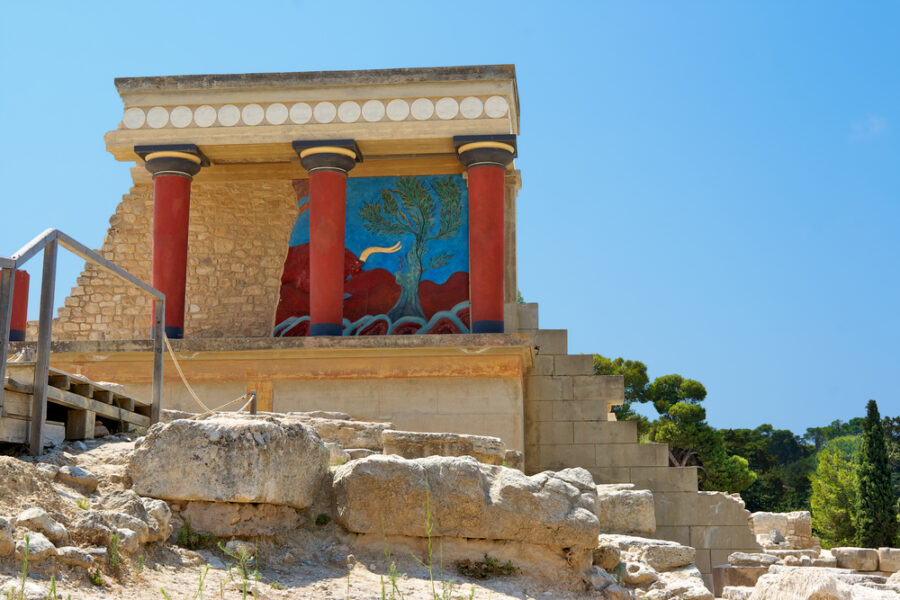
Staying in Chania puts you within striking distance of Crete’s big one: Knossos Palace near Heraklion. It’s about a two-hour drive, but if you want to see the heart of Minoan civilization, it’s worth the trip. The reconstructed palace, with its famous frescoes and legendary throne room, brings ancient myths to life.
From Nafplio, your day trips look different but just as rewarding. You’re close to Mycenae, with its iconic Lion Gate and royal tombs, and Epidaurus, home to that ancient theater still hosting shows. These UNESCO sites feel atmospheric and less crowded than Knossos—a bonus, if you ask me.
So, if Minoan history calls to you, Chania’s your gateway. If you’re more into the classical and Mycenaean worlds, Nafplio’s nearby sites are some of the best in mainland Greece.
Beaches and Natural Beauty
Both Chania and Nafplio let you dip your toes in the sea, but the experience couldn’t be more different. One offers wild, iconic stretches of sand, the other tucks you into cozy coves and smaller, quieter beaches.
Best Beaches Near Chania
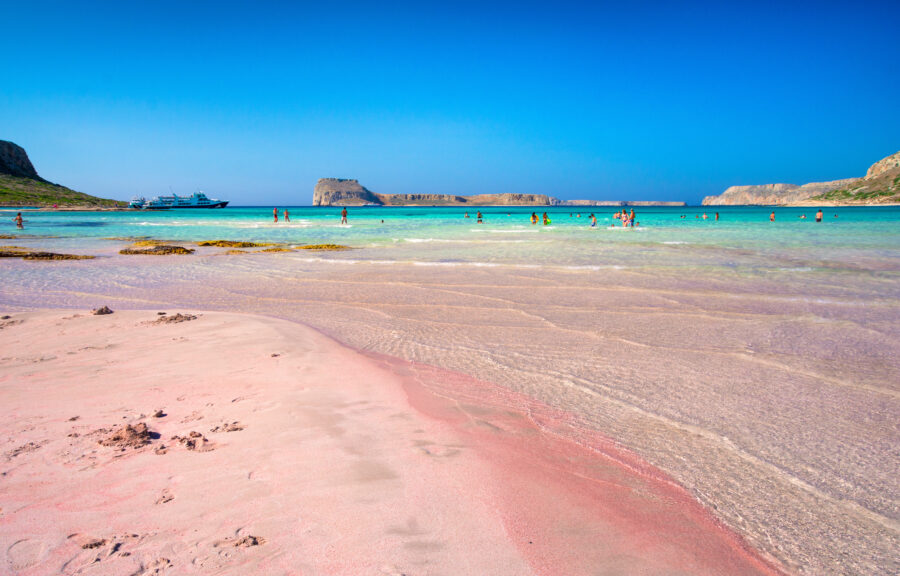
Staying in Chania pretty much spoils you with some of Crete’s famous beaches. Balos Beach is probably the one you’ve seen on Instagram—turquoise water, shallow lagoons, and a bit of a trek to get there. It’s drop-dead gorgeous, but getting there’s half the adventure, whether you hike or hop on a boat.
Elafonisi Beach is famous for its pink-tinged sand. It’s about 90 minutes from town by car, but it’s worth the drive if you want something different. Falassarna Beach is another gem—wide, open, and perfect for spreading out.
If you don’t feel like driving, you’ll find smaller, more developed beaches near Chania, lined with cafes and sunbeds. These are easy, but honestly, the best beaches take a little effort, and that’s part of the fun. You trade a bit of convenience for jaw-dropping scenery, and most of the time, it’s totally worth it.
Coastal Escapes Around Nafplio
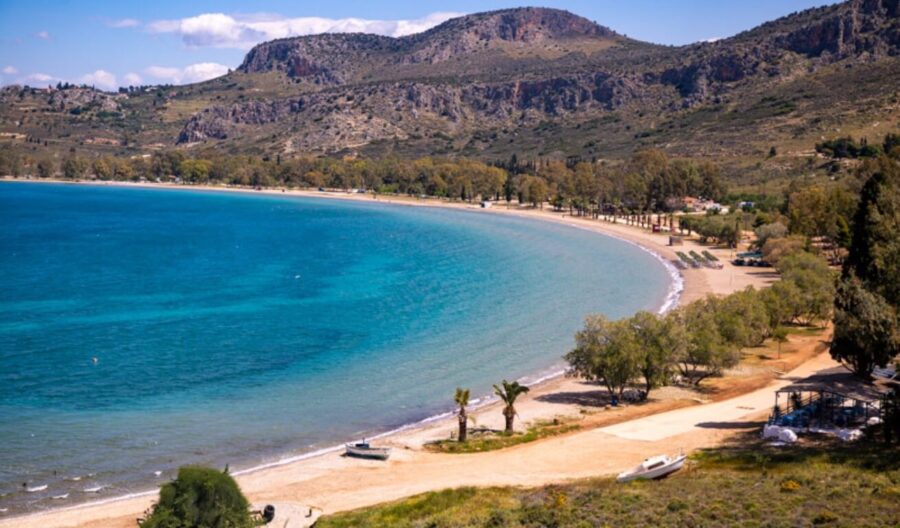
Nafplio’s beach scene? It’s way more relaxed than you might expect. You barely have to leave town to get your feet wet.
Arvanitia Beach sits right in town—a pebbly little spot you can reach in just a few minutes. It’s not sprawling, but honestly, it’s perfect for a quick dip or lazy sunbathing session.
If you’re willing to hop in a car, Karathona Beach is about 3 km away. It’s sandy, long, and feels made for those afternoons when you want to do nothing but lounge.
A bit farther out, you’ll stumble onto Tolo Beach and Kondyli Beach. Both have that clear water and quieter atmosphere I always crave—especially if you’re not into the crowds that flock to Crete’s headline beaches.
What really gets me about Nafplio’s coast is how seamlessly you can mix a morning of sightseeing with a spontaneous swim. One minute you’re wandering the old town, the next you’re floating in calm, blue water.
No need for big plans or long drives—just the kind of laid-back balance I wish every trip had.
If you want more nitty-gritty on Nafplio’s beaches, you can check out these Karathona and town beaches.
Curious about Chania’s coastline? It’s famous for a reason—Balos, Falassarna, and Elafonisi are always topping travelers’ lists.
Food, Wine, and Nightlife
Chania and Nafplio both serve up plenty to eat, drink, and do after dark—but the vibe is totally different. Chania goes bold and lively with its tavernas, while Nafplio seduces you with romantic squares, cozy wine bars, and a slow-burning nightlife that just won’t quit.
Dining Experiences in Chania
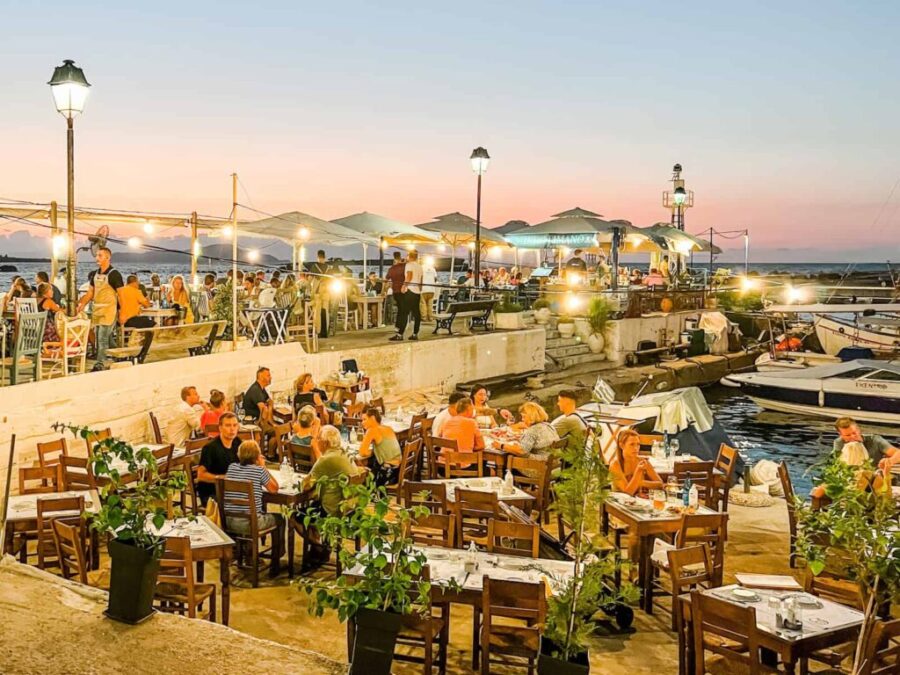
If you’re even a little bit into food, Chania on Crete is ridiculously good. The city’s earned its reputation as a Greek food hotspot, and, yeah, it lives up to the hype.
You’ll find everything from tiny family-run tavernas tucked into alleys to modern places experimenting with whatever’s fresh that day.
Seafood rules here. Seriously—octopus drying in the sun, grilled sardines, cuttlefish stews… you see it all around the Venetian Harbor.
If you’re a meat lover, Cretan lamb slow-cooked with wild herbs is the kind of dish you’ll dream about long after you leave.
I noticed that they don’t hold back on the olive oil—peppery, local, and poured over everything. Even the bread becomes special.
And if you order dakos (that crunchy barley rusk with tomatoes and cheese), it’s somehow rustic and indulgent at the same time.
Want to geek out about food? Chania’s mix of Venetian, Ottoman, and island flavors is everywhere, and here’s why it’s a must for foodies.
Culinary Scene in Nafplio
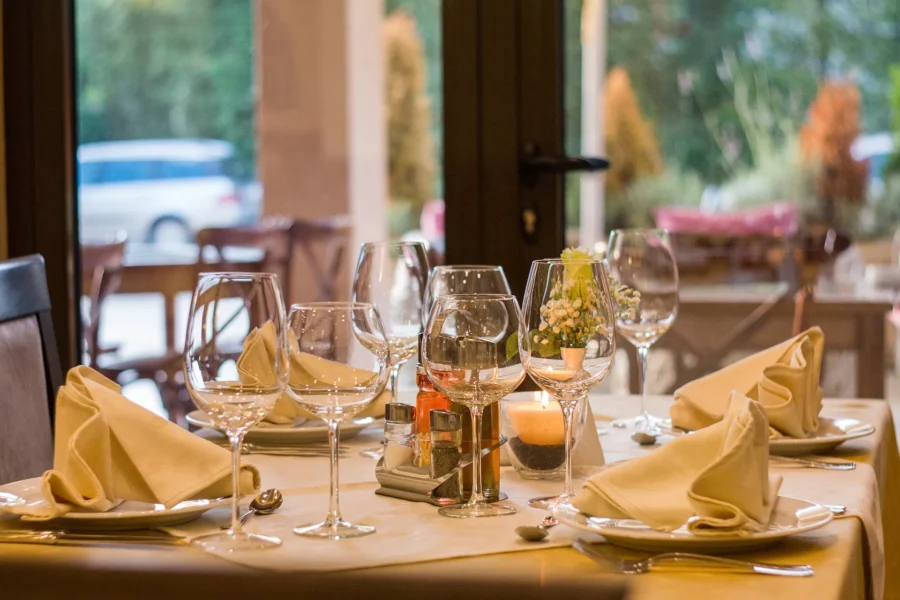
Nafplio’s food scene? It’s smaller, sure, but it’s got heart. You might not get Chania’s wild variety, but what you do find feels authentic—tied tightly to the Peloponnese.
It’s not some “food capital,” but meals here just fit the town’s romantic, easygoing pace.
I remember sitting in Syntagma Square, tucking into moussaka with a glass of local red wine. The whole experience just felt different—slower, more intimate.
Seafood’s on the menu—grilled fish, fried calamari—but you’ll also spot hearty stews, souvlaki, and fresh salads.
Most places are small, family-run, with tables spilling onto cobblestones. It’s the kind of spot where you linger over dinner, not rush through it.
Nightlife in Nafplio might surprise you. The waterfront has a strip of lively bars and tiny clubs, and spots near the old town often turn into dance venues late at night.
It’s not about food tours—it’s about long, music-filled evenings and cocktails by the sea.
Wine Culture and Local Specialties
Wine? Both regions take it seriously, but in their own ways.
Crete’s got a deep winemaking tradition, and Chania pours bold reds like Kotsifali and crisp whites like Vidiano. You’ll probably get a shot of raki (or tsikoudia) out of nowhere at the end of your meal. It’s a thing.
In Nafplio and the Peloponnese, you’ll run into Agiorgitiko, a silky red from Nemea that’s perfect with grilled meats.
If wine tasting’s your thing, this region is a top day trip from Nafplio.
Both towns love their café culture. Chania invites you to sip raki with meze in a shadowy alley, while Nafplio tempts you into stylish wine bars in the old town.
Wherever you end up, locals usually treat you like you’ve lived there for years.
And hey, if you want to end your night with something local, try ouzo in Nafplio or a glass of chilled rakomelo (that’s raki with honey) in Crete.
Little rituals like these? They’re the bits that stick with you long after you’re home.
Travel Logistics and Itineraries
Getting to Chania or Nafplio from Athens is easy enough, but how you get there shapes your whole trip. One’s a quick drive on the mainland; the other’s a flight or ferry to Crete.
Timing matters too—weather, crowds, and how many days you’ve got all change the vibe.
Getting There from Athens
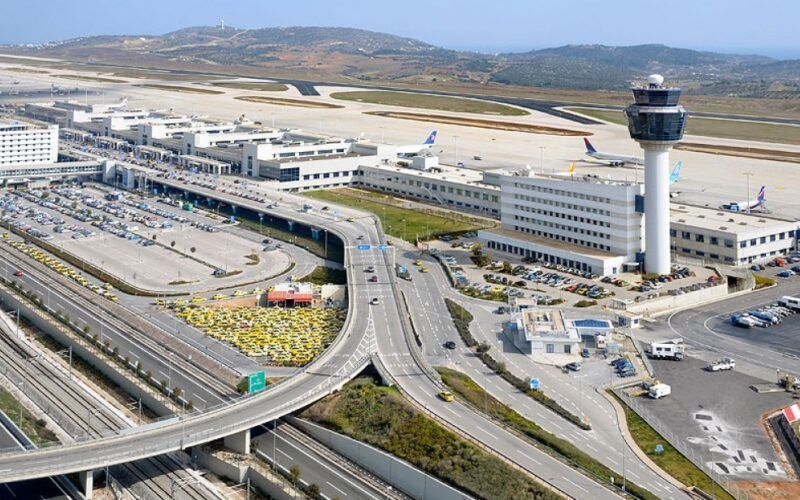
If you want to skip airports and ferries, Nafplio is the easy pick.
You can drive from Athens International Airport in about two hours. Buses work too, but a rental car lets you check out places like Mycenae and Epidaurus at your own pace.
Chania’s a bit more of an adventure. You’ll need to book a 50-minute flight or hop on an overnight ferry from Piraeus.
Flights are usually cheap if you book early, and ferries—well, I actually love them. There’s just something about watching the sunrise from the deck.
I usually check KAYAK for flights and ferries to compare.
If you’re spending time in Crete, definitely rent a car at Chania Airport. Public transport barely reaches the best beaches.
Best Times to Visit
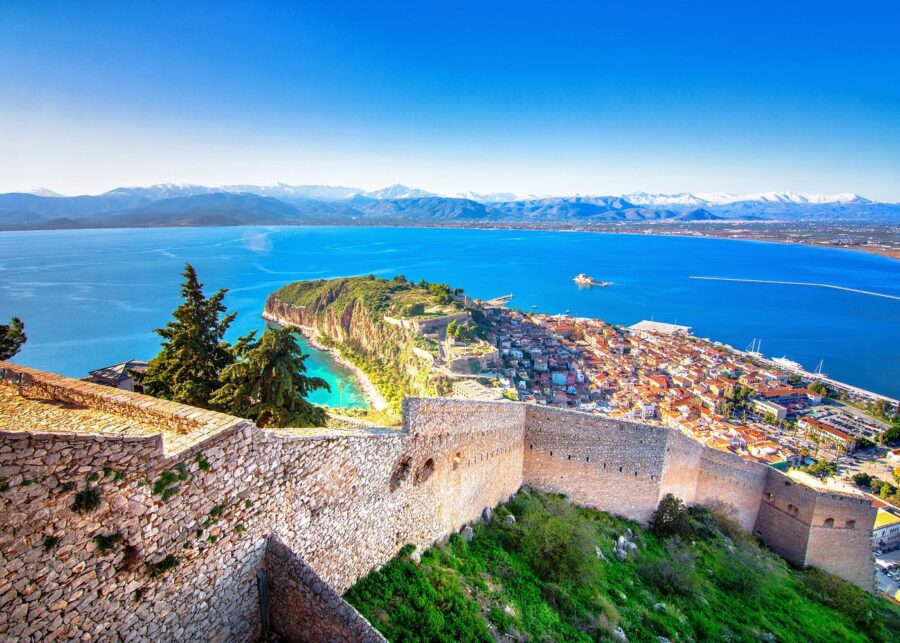
Spring and early fall are magic in both towns.
Nafplio shines from April to June—warm days, barely any crowds. October’s lovely too, especially if you want to wander the Old Town without running into tour groups every five seconds.
Chania hits its stride in late May or September. The sea’s warm, the island’s not packed, and prices aren’t sky-high.
July and August? Crowded, especially in Crete, and hotels fill up fast. Winter’s peaceful, but some places close for the season.
If you’re a planner, you can book walking tours, food tastings, or day trips on GetYourGuide or Viator.
I’ve used both for things like hiking the Samaria Gorge or exploring ruins.
Recommended Length of Stay
Nafplio is perfect for a 2–3 night visit. That’s enough to climb the Palamidi Fortress, stroll the promenade, and squeeze in a day trip to ancient sites.
If you’re short on time, even one night works—Athens is so close.
Chania? Give it 4–5 nights at least. There’s just too much to see, especially if you want to explore beyond the Old Town.
From Chania, you can hit Balos Lagoon, Elafonissi Beach, or go hiking in the White Mountains. Each of those eats up a whole day, so don’t rush it.
For places to stay, I usually browse Booking.com. They’ve got everything from boutique hotels in Nafplio to seaside villas in Crete.
If you’re coming in peak summer, book early—rooms in both places go fast.
Who Should Choose Chania or Nafplio?
Chania and Nafplio? Totally different flavors of Greece. One’s a lively island town with Venetian flair, the other’s a quieter mainland escape with neoclassical charm.
Which is right for you? Well, it comes down to what you want most from your travels.
Best for History Buffs
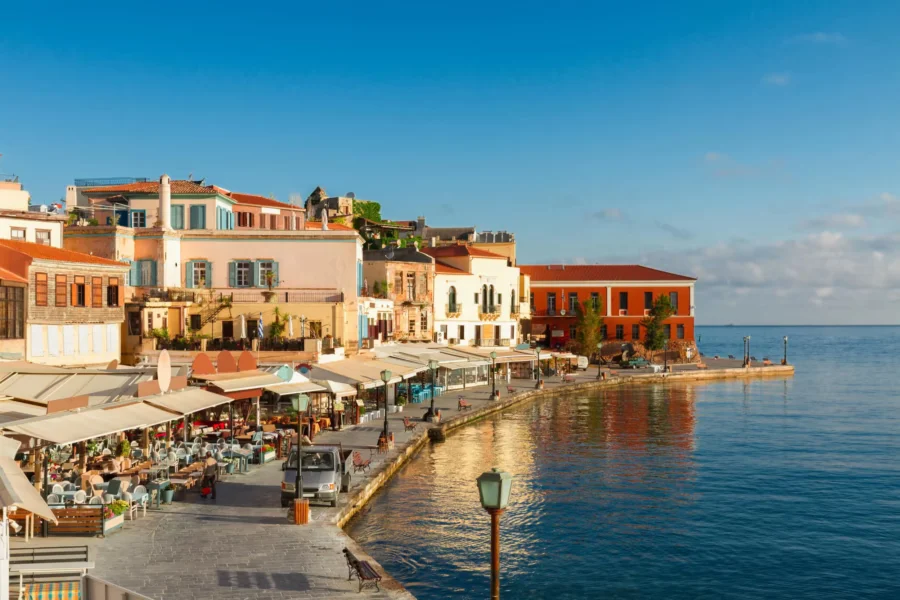
If you’re a history nerd (like me), both towns deliver, but in their own ways.
Chania, out on western Crete, is a mashup of Minoan, Venetian, and Ottoman influences. You can stroll the Old Town and spot Venetian shipyards, Ottoman baths, Byzantine churches—all within a few minutes’ walk.
It’s basically a living museum.
Nafplio (or Nafplion, depending who you ask) has a different energy. It was the first capital of modern Greece, and you can see it in the neoclassical buildings and grand squares.
The Palamidi Fortress towers above town—climb up for those epic views. And don’t miss the Bourtzi castle on its tiny island out in the harbor.
If you love getting lost down cobblestone streets with history around every corner, Nafplio might win you over.
But if you want a wild mix of cultures layered into a single city, Chania’s your ticket.
Either way, pack good walking shoes and maybe a bit of travel gear—your feet will thank you.
Ideal for Romantic Getaways
For couples, Nafplio gets called one of Greece’s most romantic towns for a reason. Pastel buildings, that seaside promenade, and cozy tavernas hidden in side streets—it all feels tailor-made for slow, dreamy evenings.
Even Greek locals treat it as a go-to weekend escape. Sunsets from the harbor? Unreal.
Chania’s got its own kind of magic, though. The Venetian harbor glows at night, with cafés spilling onto the water’s edge.
And you can mix city strolls with day trips to Crete’s showstopper beaches like Elafonissi or Balos.
If you want to linger in a quiet square with a glass of wine, Nafplio’s your spot.
But if you’d rather start your night with dinner by the harbor and end it walking the sea walls, Chania’s going to steal your heart.
Family-Friendly Options
Traveling with kids? That changes everything. Nafplio is so compact you can stroll from one end to the other without breaking a sweat, which honestly makes life way easier when you’ve got little ones in tow.
The beaches nearby, like Karathona, stay calm and shallow—ideal for a family swim. Open squares dot the town, so your kids can run wild while you sip coffee at a café and just breathe for a minute.
Chania, though, is bigger and definitely busier. That might sound like a hassle, but for families who crave variety, it’s a win. You’ll stumble on family-run tavernas everywhere, and the Old Town’s winding alleys and bursts of color feel like a playground for curious kids.
Crete’s also got those family-friendly adventures—boat trips, quick hikes through gorges, and plenty of beach days.
If you’re leaning toward a slower pace with younger kids, Nafplio probably makes more sense. But if you’ve got tweens or teens, Chania’s wild mix of history, beaches, and activities could be the thing that keeps them off their phones.
Frequently Asked Questions
So, Chania or Nafplio? It really depends on what you’re chasing. One’s got those dramatic coastlines and island vibes, the other charms you with neoclassical streets and castles, all wrapped up in that slower mainland feel.
Both towns? They’re layered with history, hidden corners, and food traditions that feel extra special when you just stumble upon them.
What unique historical sites can be explored in Chania compared to those in Nafplio?
Chania’s Venetian Harbor steals the show, lighthouse and all. You’ll wander past Ottoman baths and even spot bits of Byzantine walls if you’re paying attention.
Walking through the old town is like flipping through a storybook—every corner tells a different tale.
Nafplio leans into its fortress vibe. The Palamidi Castle towers over everything, and the little Bourtzi fortress floats right in the harbor.
I’ll never forget sweating my way up Palamidi’s steps on a blazing afternoon. The view over the Argolic Gulf made it all worth it, though—absolutely unreal.
How does the culinary experience differ between Chania and Nafplio for food-loving travelers?
If you’re a food lover, Chania’s a dream. Cretan cuisine is rustic, hearty, and full of surprises—think dakos, fresh-caught seafood, and olive oil with a peppery kick.
Meals here feel like a history lesson, with Venetian, Ottoman, and even Egyptian influences showing up on your plate.
Nafplio’s food scene sticks closer to classic mainland Greek. You’ll find tavernas serving up souvlaki, moussaka, and fish brought in from the coast that morning.
I still remember a Greek salad there—just tomatoes, feta, and olive oil, but somehow it tasted better than anything fancy. Maybe it was the sun, or maybe it’s just Nafplio.
Can you highlight the differences in the beach landscapes between Chania and Nafplio?
Chania’s beaches? Wow. You’ve seen those jaw-dropping shots of Balos Lagoon and Elafonissi—pink sand, turquoise water, the whole postcard thing.
Just know, if you visit in summer, you won’t be the only one there.
Nafplio’s beaches, like Tolo or Karathona, keep it chill. They’re nice for a swim after wandering the old town, but you won’t get that wild lagoon look.
Still, sometimes a quiet stretch of sand is exactly what you need.
In Chania, if you wander away from the harbor, you’ll find locals sipping raki in tiny kafeneia. I once ducked into a pottery workshop on a whim and ended up chatting with the owner for ages about Cretan traditions.
Nafplio’s got its own secrets tucked away. The Folklore Museum might be small, but it’s stuffed with everyday objects that tell real stories.
And if you drift away from the main square, you’ll spot family shops selling handmade jewelry or textiles—no crowds, just real people.
How do the accommodations in Chania stand out from those available in Nafplio?
Chania offers everything from boutique hotels in old Venetian mansions to simple, family-run pensions. Many places sit right in the old town, so you’ll wake up to stone walls and narrow alleys outside your window.
Nafplio’s got that small-town charm. You’ll stay in neoclassical guesthouses with balconies over tiled rooftops—less about luxury, more about cozy, romantic vibes.
Once, I stayed in a pension where the owner baked bread every morning. It felt more like visiting a friend than checking into a hotel.
What seasonal events should visitors consider when choosing between a visit to Chania or Nafplio?
Chania absolutely comes alive in summer. You’ll stumble upon festivals bursting with music, food, and those quirky local traditions that make Crete so memorable.
If you’re around in July, don’t skip the Wine Festival in nearby Rethymno—it’s honestly a blast and a great excuse to sample local wines.
Spring and autumn? Those seasons offer a quieter vibe, perfect for hiking or catching cultural events without elbowing through crowds.
Nafplio, on the other hand, moves to its own beat. Athenians flock here on weekends, so the town rarely feels sleepy.
March brings Greek Independence Day celebrations, and Nafplio really leans into its history as the first capital of modern Greece. The city fills with patriotic energy and color—kind of hard not to get swept up in it.


